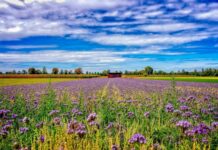Floriculture is a multi-billion dollar, international industry. It’s becoming increasingly popular worldwide, particularly in East African countries like Rwanda, Kenya and Ethiopia. Some agriculture professionals might not know about this industry since it’s considered a special category of crops.
Take a deeper look at floriculture in Africa, the benefits of integrating it into farming and what items you should consider producing on your farm.
Africa’s Booming Floriculture Industry
In 2021, Kenya exported around 10 billion Kenyan shillings (KSh) worth of cut flowers, making the country the fourth largest exporter in the world. Kenya relies on floriculture exports for its economy, so it’s no surprise that the industry is booming right now.
Every year, floriculture in Kenya accounts for $1 billion, which contributes approximately 1.1% to the country’s gross domestic product (GDP). Because African floriculture is such a lucrative export, it makes sense for African farmers to integrate this type of agriculture into their operations.
One reason why floriculture is becoming so popular is because of rapid growth in the wedding industry. Each African country differs in its wedding style and execution methods, but there’s an underlying need for couples to wow their guests. A clear way to put on a stunning ceremony is to include the finest flowers, whether in a centerpiece for the table or bouquet for the bride.
Benefits of Floriculture in Farming
Most flowers in African countries are grown on commercial farms, where they can increase curb appeal and generate extra income. Here are some other benefits of bringing floriculture to your farm:
- Provides employment opportunities
- Improves livelihood of employees and communities
- Supports economic growth
- Allows eligibility to partner with Fairtrade
- Africa offers ideal climate and growing conditions
It’s not discussed often, but some flower species are endangered or at risk of extinction. Another benefit you can reap by farming flowers is contributing to the growth of these species on an existing farm. This keeps at-risk plants alive and thriving, making your community beautiful and balanced.
Types of Floriculture Items to Add to Your Farm
Which floriculture items should you consider growing on your farm to increase your income? Here are some of the flowers taking over the industry in Africa.
Roses
Kenya is a hotspot for rose farms. Roses symbolize love and passion, and they even represented confidentiality in ancient Rome. They are also popular flower choices for a bride’s wedding bouquet.
African Violets
There’s a high concentration of African violets, also called Saintpaulias, in the Nguru Mountains. Several species are endangered because their habitats are often cleared for traditional agriculture. Conservation efforts are in place to keep African violets blooming.
Carnations
Another popular flower exported by African countries is the carnation. Carnations are also widely used for weddings. They are said to represent good luck and pure love.
Lilies
White lilies are used in weddings to represent virginity and purity, but they’re also seen as a religious symbol in Christianity. Lilies are used in funeral processions to symbolize mourning and loss and to show that the departed person is well-received in the afterlife.
Proteas
Proteas, also called sugarbushes, are a genus of South African flowering plants. It’s native to South Africa, which is the leading region of proteas exports. Around 92% of the species are located in the Cape Floristic Region in the Western Cape.
Incorporate Floriculture on Your Farm
Floriculture is an essential part of various African countries’ economies. Consider growing flowers on your farm if you’re looking to generate income through another revenue source. Many commercial farms in Africa grow them, so why not follow suit and export them to increase your profitability?

Jane is an agriculture and environmental journalist and the founder and editor-in-chief of Environment.co, where she covers sustainability and eco-friendly living








